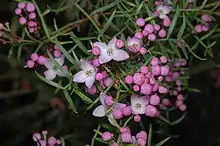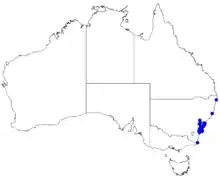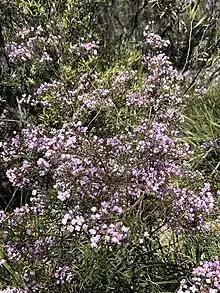| Bronzy boronia | |
|---|---|
 | |
| Boronia thujona in the Australian National Botanic Gardens | |
| Scientific classification | |
| Kingdom: | Plantae |
| Clade: | Tracheophytes |
| Clade: | Angiosperms |
| Clade: | Eudicots |
| Clade: | Rosids |
| Order: | Sapindales |
| Family: | Rutaceae |
| Genus: | Boronia |
| Species: | B. thujona |
| Binomial name | |
| Boronia thujona A.R.Penfold & M.B.Welch[1] | |
 | |
| Occurrence data from Australasian Virtual Herbarium | |

Boronia thujona, commonly known as the bronzy boronia,[2] is a plant in the citrus family Rutaceae and is endemic to near coastal areas of southern New South Wales. It is a shrub or small tree with aromatic, pinnate leaves and groups of between two and six bright pink flowers in the leaf axils.
Description
Boronia thujona is a glabrous shrub or small tree that grows to a height of 1–4 m (3–10 ft) with two grooves between the leaf bases on the smaller stems. It has aromatic, pinnate leaves with between three and fifteen leaflets. The leaf is 30–80 mm (1–3 in) long and 23–70 mm (0.9–3 in) wide in outline with a petiole 10–15 mm (0.4–0.6 in) long. The end leaflet is narrow elliptic in shape, 5–25 mm (0.2–1 in) long and 1–4 mm (0.04–0.2 in) wide and the side leaflets are similar but usually longer. The flowers are bright pink and are arranged in pairs or groups of up to six in leaf axils, each flower on a pedicel 5–15 mm (0.2–0.6 in) long. The four sepals are triangular, 0.5–1.5 mm (0.02–0.06 in) long, 0.5–1 mm (0.02–0.04 in) wide. The four petals are 5–10 mm (0.2–0.4 in) long with a hairy lower surface and a small point on the tip. The eight stamens have hairy filaments. The stigma is about the same width as the style. Flowering occurs from August to November and the fruit is a glabrous capsule 3–4 mm (0.12–0.16 in) long and 2–2.5 mm (0.08–0.1 in) wide.[2][3]
Taxonomy and naming
Boronia thujona was first formally described in 1922 by Arthur de Ramon Penfold and Marcus Baldwin Welch and the description was published in Journal and proceedings of the Royal Society of New South Wales.[4][5] The specific epithet (thujona) refers to the ketone, thujone that Penfold, a chemist, and Welch, an economic botanist, extracted from this plant.[2][5][6][7]
The common name, bronzy boronia, was first used by Jean Galbraith in 1977 and refers to a bronze sheen, sometimes present on the leaves.[2]
Distribution and habitat
The bronzy boronia grows in damp, shady forest in the Sydney region and south to the Budawang Range.[2]
References
- ↑ "Boronia thujona". Australian Plant Census. Retrieved 17 March 2019.
- 1 2 3 4 5 Duretto, Marco F. (2003). "Notes on Boronia (Rutaceae) in eastern and northern Australia" (PDF). Muelleria. 17: 66–67. Archived from the original (PDF) on 6 April 2020. Retrieved 18 February 2019.
- ↑ "Boronia thujona". Royal Botanic Garden Sydney. Retrieved 18 February 2019.
- ↑ "Boronia thujona". APNI. Retrieved 18 February 2019.
- 1 2 Penfold, Arthur R.; Welch, Marcus B. (1922). "Two pinnate leaf boronias and their essential oils with description of a new species". Journal and Proceeding of the Royal Society of New South Wales. 55: 196–209. Retrieved 18 February 2019.
- ↑ "Penfold, Arthur (de) Ramon (1890 - 1980)". Australian National Herbarium. Retrieved 19 February 2019.
- ↑ "Welch, Marcus Baldwin (1895 - 1942)". Australian National Herbarium. Retrieved 19 February 2019.